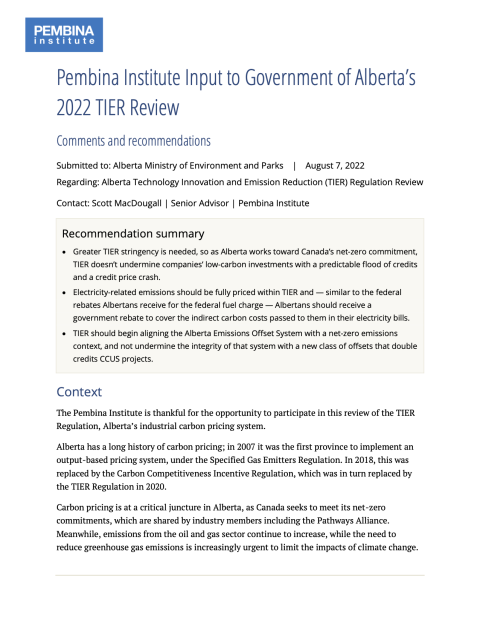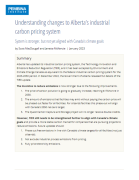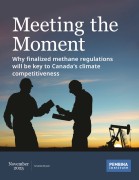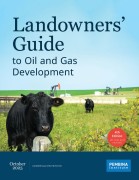The Pembina Institute is thankful for the opportunity to participate in this review of the TIER Regulation, Alberta’s industrial carbon pricing system.
Alberta has a long history of carbon pricing; in 2007 it was the first province to implement an output-based pricing system, under the Specified Gas Emitters Regulation. In 2018, this was replaced by the Carbon Competitiveness Incentive Regulation, which was in turn replaced by the TIER Regulation in 2020.
Carbon pricing is at a critical juncture in Alberta, as Canada seeks to meet its net-zero commitments, which are shared by industry members including the Pathways Alliance. Meanwhile, emissions from the oil and gas sector continue to increase, while the need to reduce greenhouse gas emissions is increasingly urgent to limit the impacts of climate change.
Industrial carbon pricing systems are meant to concurrently reduce emissions while ensuring that regulated sectors can remain competitive. Effective carbon pricing systems should adhere to the following principles:
- Maintain the incentive to reduce GHG emissions, aiming to achieve net-zero by 2050;
- Be targeted by applying protection only to sectors that are truly emissions intensive and trade exposed;
- Be transparent, with support for emissions intensive trade exposed (EITE) sectors supported by available data;
- Be consistent across sectors and firms;
- Be temporary, understanding that support should be phased out as other jurisdictions implement equivalent GHG-reduction policies;
- Be simple to implement, administer, and comply with.
TIER is inherently inefficient compared to its predecessor, CCIR, because it sets emissions-intensity thresholds that are based on individual facility performance instead of sector performance. This system rewards companies that haven’t taken any action and punishes first-mover firms.
We recommend the following improvements to TIER:
- Strengthen to align with net-zero commitments that Canada has made which are supported by industry, including the Pathways Alliance. This is needed so that Alberta contributes its fair share in achieving Canada’s net-zero commitment, while avoiding undermining industry low-carbon investments with an avoidable oversupply of credits.
- Fully price electricity-related emissions to align with the federal CER, as the sector is neither inherently emissions-intensive nor trade-exposed. Like the federal rebates for the federal fuel charge, Albertans should receive a rebate for the indirect carbon costs that are passed on in their electricity bills.
- Start aligning the Alberta Emissions Offset System with a net-zero emissions context, and not undermine the integrity of that system with a new class of offsets that allows double-counting credits for CCUS projects.
Increasing TIER stringency can align TIER with Canada’s net-zero commitments, send a clear and credible signal that Alberta is committed to maintaining the marginal price on carbon, and provide investors with confidence in Alberta’s future credit prices.







